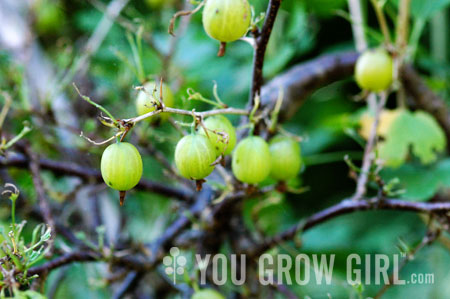
These gooseberries aren’t from my garden, although judging by the chewed up state of its leaves I’d hazard a guess that they have suffered a similar plight.
A week or two back, what was supposed to be a quick trip to the community garden turned into a caterpillar squishing marathon. The gooseberry bush and the unknown bush that I think might be a black currant were teaming with teeny, tiny, very hungry currant worms, the larvae of a sawfly that specifically target currant bushes.
The little worms are pretty near impossible to detect since they are the same colour as the foliage they feast on. We found that the easiest way to find them was to follow damaged leaves — the larvae sat perfectly along the margins, hugging the curve of the leaf where they were eating.
How did we get rid of them you ask? Well, this is the first time any of my currant plants have been infested by this pest so we were caught unawares at the community garden without the usual tools: bucket, water, and soap. My usual response to this sort of situation would be to pick the worms off by hand and drop them into a bucket of soapy water. Many sites suggest spraying in these sorts of situations but I find that sprays don’t help, even the organic and supposedly safe ones. When you spray, you always run the risk of killing beneficial insects. The other problem with sprays is that they really have to get on the larvae directly in order to kill them. It just makes more sense to pluck them off by hand. It’s the same amount of work without the risk of damaging the plant or the ecological balance of your garden.
Unfortunately, we were stuck at the community garden without any supplies and had to make due with our fingers alone, squishing the little worms one at a time. I initially tried squishing them under my shoe but this proved to be time consuming since I had to crouch down low to get to the worms where they were hiding out in the shady and cool lower regions of the plant. I probably squished about hundred or possibly hundreds even (I wasn’t counting) this way. DELIGHTFUL!
Even weirder, when we were done, a bunch of carnivorous insects flew over and ate the wormy residue off the leaves!
Then I went to the liquor store to pick up a bottle of wine carrying my compost pail and covered in dirt, larvae residue lingering underneath my fingernails.
The good news is that we seemed to catch them before any real damage was done. The plants have sustained only minor defoliation and there are loads of berries ripening on the bush. On a positive note, the presence of the currant worm on the possible black currant bush proves that it is definitely some kind of currant.
It turns out that insect infestations can serve a useful purpose!
Wow, that’s really interesting, thanks for this post! It’s my first year with my black currants, and I didn’t even know there was a specific currant worm that’ll I should watch for signs of.
Good on you for squishing with your fingers too, that’s dedication right there.
I’ve had to do the same with my redcurrants. If it gets any worse, I’ll probably have to use a homemade chilli spray to get rid of them as squishing them takes up more time than I can give!
You’re a bigger woman than me, HAND PICKING every offending creature! I tried to hand pick every offending, tiny caterpillar from my tomatoes and eggplants but I lost to the 100 degree heat and humidity. There’s STILL some out there…
I don’t like killing worms or bugs. I am afraid that if I did, it might contribute to their extinction. I usually put worms in a container and drive them to the bushland and release them.